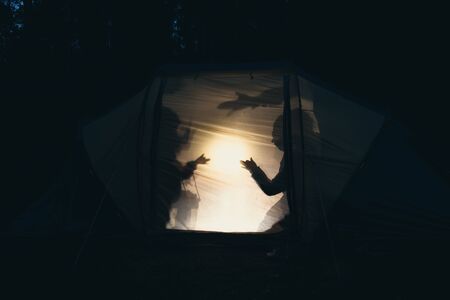Understanding Summer Camping Conditions
Summer camping in the U.S. is all about embracing the outdoors, but it comes with a unique set of challenges. The heat can be relentless, and high humidity levels can make even a short hike feel exhausting. Sudden rain showers are common, turning dry trails into muddy paths in minutes. And then there are the bugs—mosquitoes, ticks, and flies—ready to test your patience at dusk and dawn. Knowing these key challenges is the first step to packing smart and dressing right. Your clothing choices should help you stay cool under the sun, dry during pop-up storms, and protected from biting insects, so you can focus on enjoying nature’s beauty rather than battling discomfort.
Choosing Breathable, Quick-Dry Fabrics
When summer camping, your comfort starts with what you wear. The right fabrics help you stay cool, dry, and comfortable even when temperatures rise. Here’s how to choose clothing that works with nature—not against it.
Why Fabric Choice Matters
Cotton may feel soft but holds onto moisture and dries slowly. For hot days outdoors, opt for fabrics designed to wick sweat away from your skin and release heat quickly. This keeps you dry and helps prevent chafing or discomfort.
Top Fabric Picks for Summer Camping
| Fabric Type | Main Benefits | Best Use |
|---|---|---|
| Polyester | Lightweight, quick-drying, wicks moisture | T-shirts, shorts, base layers |
| Nylon | Durable, breathable, resists abrasion | Pants, jackets, outerwear |
| Merino Wool | Soft on skin, natural odor resistance, regulates temperature | Socks, lightweight shirts |
| Bamboo Viscose | Eco-friendly, naturally antibacterial, airy feel | Undergarments, tees |
| Linen Blends | Highly breathable, natural fibers, dries fast | Shirts, loose pants |
Quick Tips for Picking the Right Clothing:
- Look for “moisture-wicking” or “quick-dry” labels on tags.
- Avoid heavy cotton and denim—they trap sweat and take forever to dry.
- Choose light colors to reflect sunlight and stay cooler.
- Select loose-fitting garments for better airflow.
- If bugs are an issue in your camping area, consider clothes treated with insect repellent or tightly woven fabrics.
The goal: keep it simple and functional. Prioritize natural movement and materials that help your body breathe. With the right fabrics, every hike or campfire feels a little more effortless—and a lot more comfortable.

3. Layering for Day and Night Comfort
Smart layering is the secret to staying comfortable while camping in summer. During the day, start with a lightweight, moisture-wicking base layer—think a breathable tee or tank made of merino wool or technical synthetic fabric. This keeps sweat off your skin and helps you stay cool as temperatures climb. In the evening, when the sun dips and the air cools, add a long-sleeve shirt or a thin fleece pullover. This extra layer traps warmth without overheating you. If it gets chilly, a light puffer jacket or windbreaker can provide just enough insulation, especially if you’re sitting around the campfire. The key is to choose layers that are easy to pack, quick to dry, and simple to peel off or add as conditions change. Avoid heavy cotton pieces—they hold onto moisture and can leave you cold once the sun goes down. Instead, opt for versatile clothing that moves with you from sunny hikes to starlit nights, helping you feel at home in nature’s rhythm.
4. Strategies to Stay Bug-Free
When summer camping, protecting yourself from mosquitoes and ticks is essential for comfort and health. Dressing wisely can make a big difference. Here’s how to naturally guard against bugs with the right clothing and thoughtful add-ons.
Choose Smart Fabrics and Fits
Lightweight, tightly woven fabrics act as a natural barrier against biting insects. Opt for long sleeves and pants, even in warm weather—breathable materials like nylon or polyester blends help you stay cool while keeping skin covered. Loose fits are best; they allow air flow and make it harder for bugs to bite through fabric.
Wear Light Colors
Dark colors attract mosquitoes and can make you hotter under the sun. Stick to light shades like beige, white, or pastels to stay both cooler and less noticeable to bugs.
Add-On Protection: Clothing Accessories
| Accessory | Purpose | Best For |
|---|---|---|
| Wide-brim Hat | Shields face and neck from sun & bugs | Day hikes, campsite lounging |
| Neck Gaiter or Bandana | Covers exposed neck, can be treated with repellent | Dense woods, dusk/dawn hours |
| Socks Over Pants | Prevents ticks from crawling up legs | Tall grass, tick-prone areas |
| Insect Shield Clothing | Permanently treated fabric offers extra bug resistance | All-day wear, high-risk locations |
Extra Tips for Natural Defense
- Tuck shirts into pants and pants into socks for full coverage.
- If using bug spray, apply it on top of clothing (not just skin) for enhanced protection.
- Avoid scented lotions or perfumes—they can attract insects.
- Launder camp clothes separately at home to remove bug-repellent residue safely.
By choosing the right layers and simple add-ons, you’ll enjoy summer camping with fewer bites and more peace of mind.
5. Footwear for Summer Trails and Campsites
Choosing the right footwear can make or break your summer camping experience. When days are hot and trails unpredictable, it’s important to pick shoes that balance durability, comfort, and breathability.
Sturdy Soles for Mixed Terrain
Look for hiking boots or trail shoes with grippy outsoles—think deep treads and flexible support. Whether you’re trekking forest paths or rocky riverbanks, sturdy soles help prevent slips and protect your feet from sharp stones and roots.
Breathable Materials Keep Feet Cool
Summer heat demands shoes that let your feet breathe. Mesh panels, lightweight textiles, and moisture-wicking linings are essential. They reduce sweat, help avoid blisters, and keep you feeling fresh through long days outdoors.
Water-Ready Options
Campsites often mean morning dew, creek crossings, or sudden rain showers. Water-resistant hiking sandals or quick-drying trail runners are excellent choices. They dry fast if you get wet and don’t hold onto mud or moisture, so you stay comfortable as you move from campsite to swimming hole.
Don’t Forget Camp Shoes
After a day on the trails, slipping into soft camp shoes—like lightweight slip-ons or supportive sandals—lets your feet relax while still keeping them safe from rocks and bugs around camp.
Pro tip: Always pack an extra pair of socks made from merino wool or synthetic fibers. Dry feet are happy feet!
6. Accessory Essentials: Hats, Sunglasses, and More
When you’re camping in the summer, accessories are more than just style—they’re about staying cool, protected, and comfortable.
Hats: Your First Line of Defense
A wide-brimmed hat is a must-have for every camper. It shields your face, neck, and ears from direct sunlight, reducing the risk of sunburn and heat exhaustion. Lightweight, breathable fabrics like cotton or nylon work best. If you’ll be hiking or near water, consider a hat with an adjustable strap so it doesn’t blow away.
Sunglasses: Protect Your Eyes
Don’t underestimate the power of quality sunglasses. Look for polarized lenses that block 100% UVA and UVB rays to keep your eyes safe from harsh summer glare. Sunglasses also help prevent headaches and eye strain during long days outdoors.
Bandanas and Buffs: Versatile Protection
A simple bandana or a moisture-wicking buff can serve multiple purposes—wipe away sweat, cover your neck from the sun, or use as a makeshift mask when trails get dusty. These small items pack easily and add big comfort value.
Bug Shields: Stay Bite-Free
Consider wearing a lightweight bug net hat or treating your accessories with insect repellent. Mosquitoes and ticks thrive in summer campsites, so keeping them at bay helps you enjoy your trip without itchy distractions.
Other Must-Haves
Lightweight gloves can protect your hands when gathering firewood or exploring rugged terrain. And don’t forget a headlamp or flashlight—sunset comes quickly in the woods.
Minimal Gear, Maximum Comfort
The right accessories keep you shaded, dry, and free from campsite surprises. Pack thoughtfully to stay cool and make the most of your summer camping experience.
7. Eco-Friendly and Minimal Packing Tips
When heading out for a summer camping trip, it’s easy to overpack “just in case.” But embracing minimalism not only lightens your load—it also lessens your impact on the beautiful places you’re visiting. Start by choosing versatile clothing: opt for moisture-wicking tops, convertible pants, and a lightweight jacket that can handle both cool evenings and warm days. Stick to neutral colors that blend into nature and resist showing dirt, so you can wear items multiple times.
Pack Less, Experience More
Bring only what you need. Consider the duration of your trip and plan outfits accordingly. A good rule is one set of clothes for the day, one for sleeping, and a spare—plus essentials like socks and underwear. If you’ll be gone longer than a few days, bring biodegradable soap to wash garments at camp.
Eco-Conscious Choices
Choose gear made from recycled or natural materials. Leave single-use plastics behind; instead, pack reusable water bottles, utensils, and food containers. Opt for biodegradable bug sprays and sunscreens to protect waterways and wildlife.
Leave No Trace
Always follow Leave No Trace principles. Avoid bringing unnecessary packaging, and pack out everything you bring in—including micro-trash like wrappers or clothing tags. Respect local flora by sticking to established trails and campsites. With thoughtful packing and an eco-friendly mindset, you’ll help keep America’s wild spaces healthy for everyone who comes after you.


